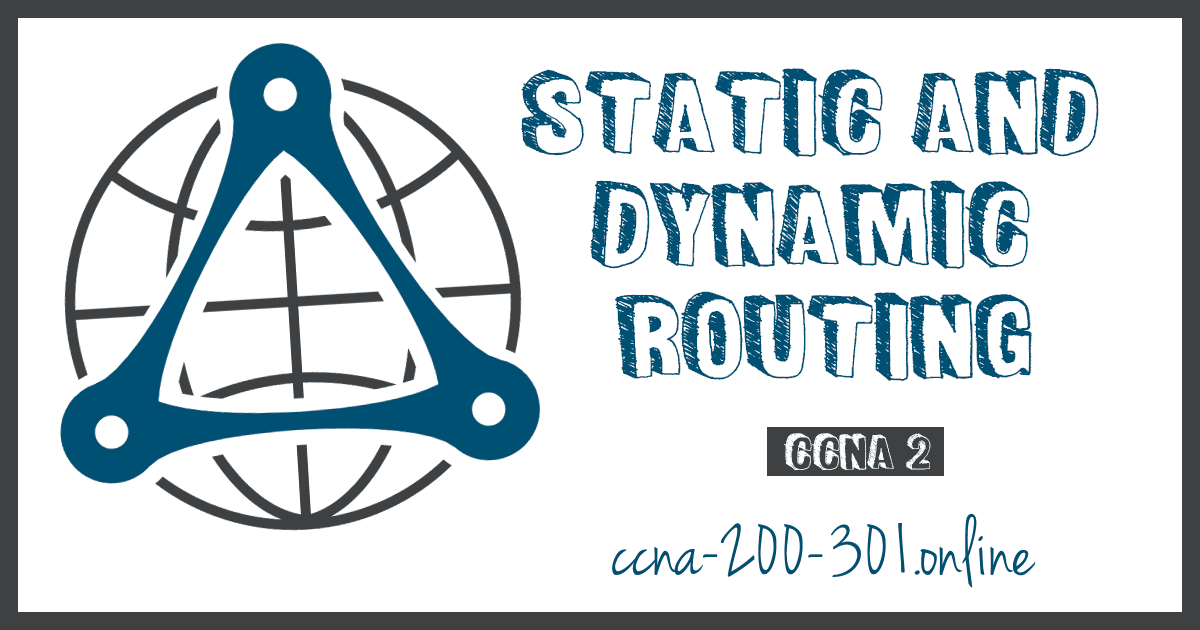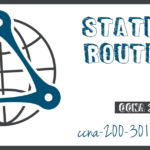Static and Dynamic Routing
Summary
This topic compare static and dynamic routing concepts. Start learning CCNA 200-301 for free right now!!
Table of Contents
Static or Dynamic?
The previous topic discussed the ways that a router creates its routing table. So, you now know that routing, like IP addressing, can be either static or dynamic. Should you use static or dynamic routing? The answer is both! Static and dynamic routing are not mutually exclusive. Rather, most networks use a combination of dynamic routing protocols and static routes.
Static Routes
Static routes are commonly used in the following scenarios:
- As a default route forwarding packets to a service provider
- For routes outside the routing domain and not learned by the dynamic routing protocol
- When the network administrator wants to explicitly define the path for a specific network
- For routing between stub networks
Static routes are useful for smaller networks with only one path to an outside network. They also provide security in a larger network for certain types of traffic, or links to other networks that need more control.
Dynamic Routing Protocols
Dynamic routing protocols help the network administrator manage the time-consuming and exacting process of configuring and maintaining static routes. Dynamic routing protocols are implemented in any type of network consisting of more than just a few routers. Dynamic routing protocols are scalable and automatically determine better routes if there is a change in the topology.
Dynamic routing protocols are commonly used in the following scenarios:
- In networks consisting of more than just a few routers
- When a change in the network topology requires the network to automatically determine another path
- For scalability. As the network grows, the dynamic routing protocol automatically learns about any new networks.
The table shows a comparison of some the differences between dynamic and static routing.
| Feature | Dynamic Routing | Static Routing |
|---|---|---|
| Configuration complexity | Independent of network size | Increases with network size |
| Topology changes | Automatically adapts to topology changes | Administrator intervention required |
| Scalability | Suitable for simple to complex network topologies | Suitable for simple topologies |
| Security | Security must be configured | Security is inherent |
| Resource Usage | Uses CPU, memory, and link bandwidth | No additional resources needed |
| Path Predictability | Route depends on topology and routing protocol used | Explicitly defined by the administrator |
Dynamic Routing Evolution
Dynamic routing protocols have been used in networks since the late 1980s. One of the first routing protocols was RIP. RIPv1 was released in 1988, but some of the basic algorithms within the protocol were used on the Advanced Research Projects Agency Network (ARPANET) as early as 1969.
As networks evolved and became more complex, new routing protocols emerged. The RIP protocol was updated to RIPv2 to accommodate growth in the network environment. However, RIPv2 still does not scale to the larger network implementations of today. To address the needs of larger networks, two advanced routing protocols were developed: OSPF and Intermediate System-to-Intermediate System (IS-IS). Cisco developed the Interior Gateway Routing Protocol (IGRP), which was later replaced by Enhanced IGRP (EIGRP), which also scales well in larger network implementations.
Additionally, there was the need to connect the different routing domains of different organizations and provide routing between them. The Border Gateway Protocol (BGP), the successor of Exterior Gateway Protocol (EGP) is used between Internet Service Providers (ISPs). BGP is also used between ISPs and some private organizations to exchange routing information.
The figure displays the timeline of when the various protocols were introduced.

To support IPv6 communication, newer versions of the IP routing protocols have been developed, as shown in the IPv6 row in the table.
The table classifies the current routing protocols. Interior Gateway Protocols (IGPs) are routing protocols used to exchange routing information within a routing domain administered by a single organization. There is only one EGP and it is BGP. BGP is used to exchange routing information between different organizations, known as autonomous systems (AS). BGP is used by ISPs to route packets over the internet. Distance vector, link-state, and path vector routing protocols refer to the type of routing algorithm used to determine best path.
| Interior Gateway Protocols | Exterior Gateway Protocols | ||||
|---|---|---|---|---|---|
| Distance Vector | Link-State | Path Vector | |||
| IPv4 | RIPv2 | EIGRP | OSPFv2 | IS-IS | BGP-4 |
| IPv6 | RIPng | EIGRP for IPv6 | OSPFv3 | IS-IS for IPv6 | BGP-MP |
Dynamic Routing Protocol Concepts
A routing protocol is a set of processes, algorithms, and messages that are used to exchange routing information and populate the routing table with the choice of best paths. The purpose of dynamic routing protocols includes the following:
- Discovery of remote networks
- Maintaining up-to-date routing information
- Choosing the best path to destination networks
- Ability to find a new best path if the current path is no longer available
The main components of dynamic routing protocols include the following:
- Data structures – Routing protocols typically use tables or databases for their operations. This information is kept in RAM.
- Routing protocol messages – Routing protocols use various types of messages to discover neighboring routers, exchange routing information, and other tasks to learn and maintain accurate information about the network.
- Algorithm – An algorithm is a finite list of steps used to accomplish a task. Routing protocols use algorithms for facilitating routing information and for the best path determination.
Routing protocols allow routers to dynamically share information about remote networks and automatically offer this information to their own routing tables. Click Play to see an animation of this process.
Routing protocols determine the best path, or route, to each network. That route is then offered to the routing table. The route will be installed in the routing table if there is not another routing source with a lower AD. A primary benefit of dynamic routing protocols is that routers exchange routing information when there is a topology change. This exchange allows routers to automatically learn about new networks and to find alternate paths when there is a link failure to a current network.

Best Path
Before a path to a remote network is offered to the routing table, the dynamic routing protocol must determine the best path to that network. Determining the best path may involve the evaluation of multiple paths to the same destination network and selecting the optimum or shortest path to reach that network. Whenever multiple paths to the same network exist, each path uses a different exit interface on the router to reach that network.
The best path is selected by a routing protocol based on the value or metric it uses to determine the distance to reach a network. A metric is the quantitative value used to measure the distance to a given network. The best path to a network is the path with the lowest metric.
Dynamic routing protocols typically use their own rules and metrics to build and update routing tables. The routing algorithm generates a value, or a metric, for each path through the network. Metrics can be based on either a single characteristic or several characteristics of a path. Some routing protocols can base route selection on multiple metrics, combining them into a single metric.
The following table lists common dynamic protocols and their metrics.
| Routing Protocol | Metric |
|---|---|
| Routing Information Protocol (RIP) |
|
| Open Shortest Path First (OSPF) |
|
| Enhanced Interior Gateway Routing Protocol (EIGRP) |
|
The animation in the figure highlights how the path may be different depending on the metric being used. If the best path fails, the dynamic routing protocol will automatically select a new best path if one exists.

Load Balancing
What happens if a routing table has two or more paths with identical metrics to the same destination network?
When a router has two or more paths to a destination with equal cost metrics, then the router forwards the packets using both paths equally. This is called equal cost load balancing. The routing table contains the single destination network, but has multiple exit interfaces, one for each equal cost path. The router forwards packets using the multiple exit interfaces listed in the routing table.
If configured correctly, load balancing can increase the effectiveness and performance of the network.
Equal cost load balancing is implemented automatically by dynamic routing protocols. It is enabled with static routes when there are multiple static routes to the same destination network using different next-hop routers.

The animation in the figure provides an example of equal cost load balancing.
The figure is an animation with four routers R1,R2,R3, and R4 interconnected to each other with 52Mbps connections. A PC labeled PC1 is connected to R1 and a second PC labeled to PC2 is connected to R3. When the animation runs packets from PC1 takes various paths thru the routers to PC2 which illustrate equal cost load balancing since all routers have equal connection speeds.
Ready to go! Keep visiting our networking course blog, give Like to our fanpage; and you will find more tools and concepts that will make you a networking professional.





